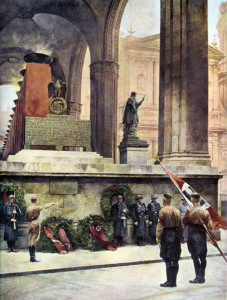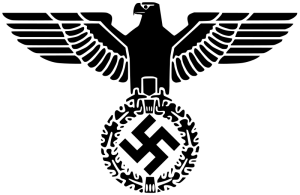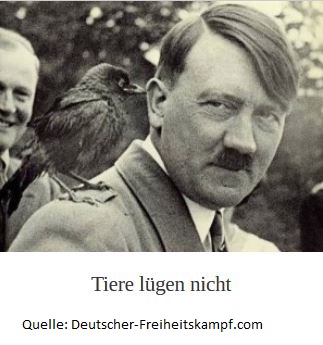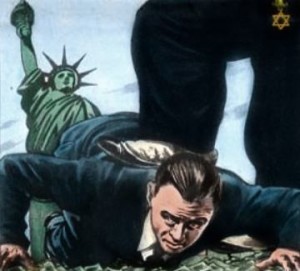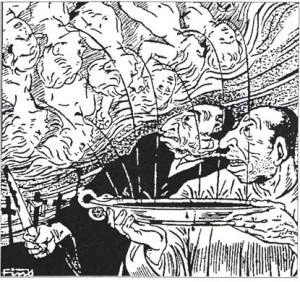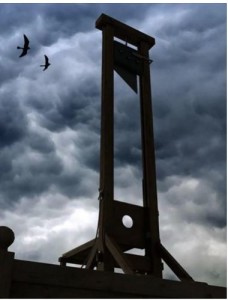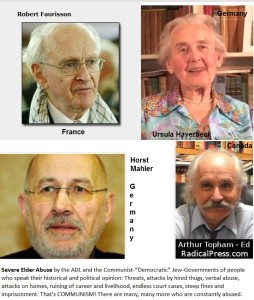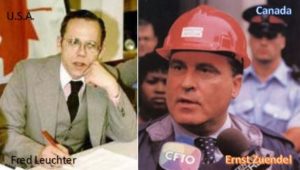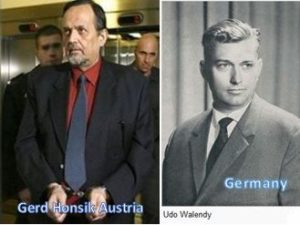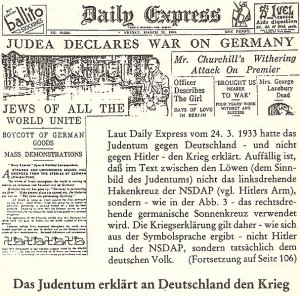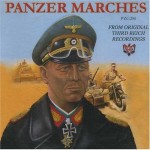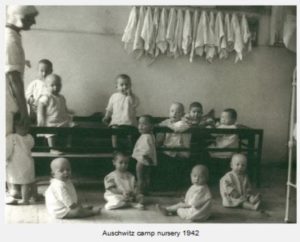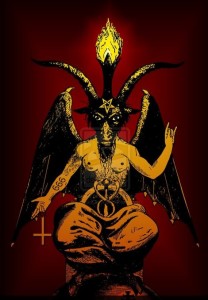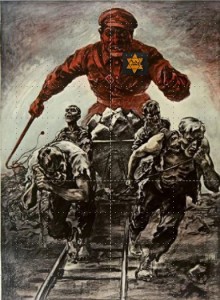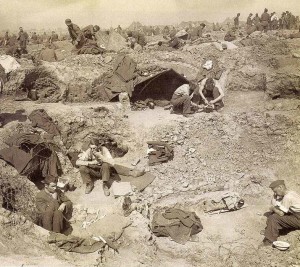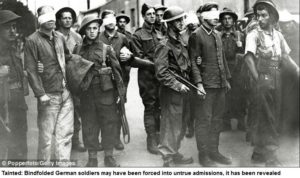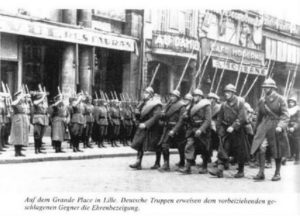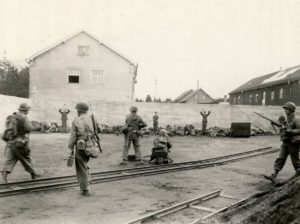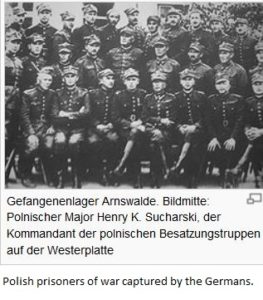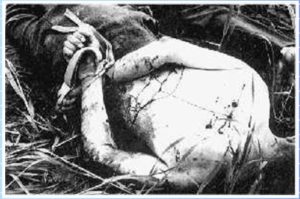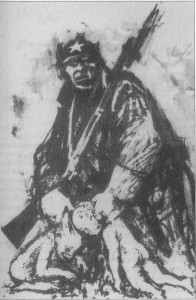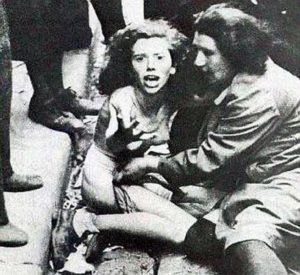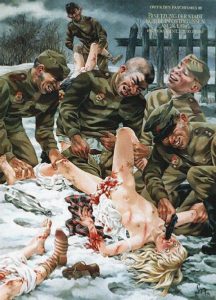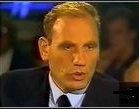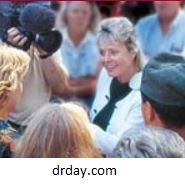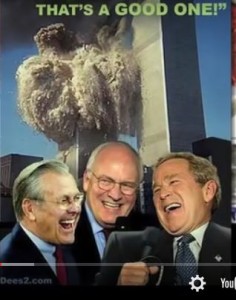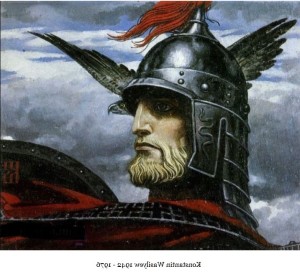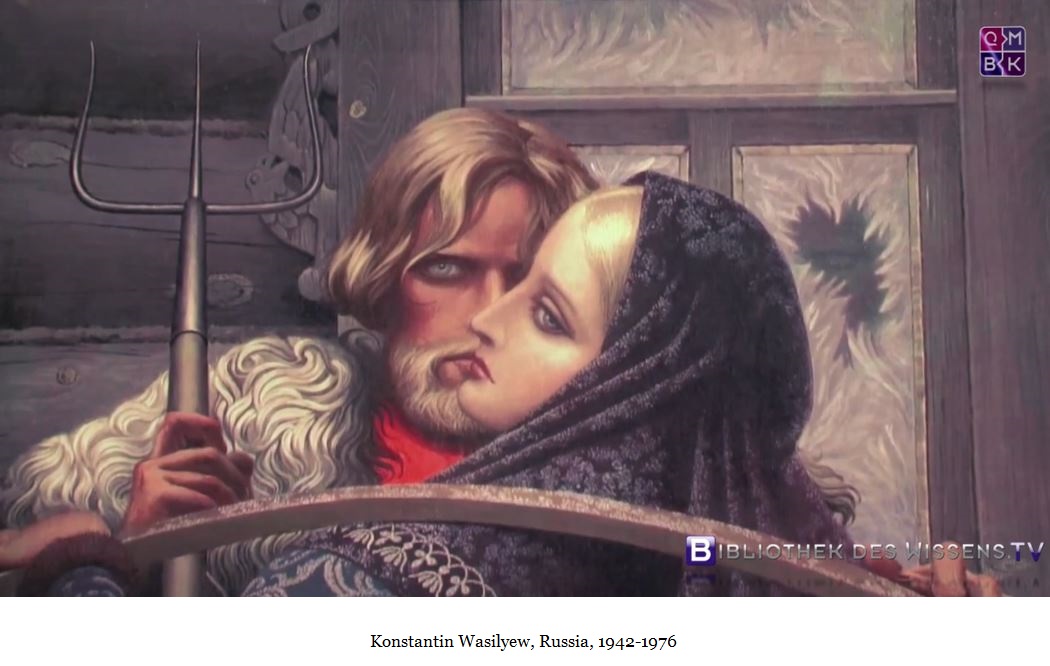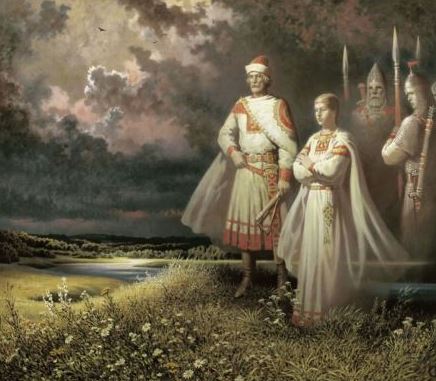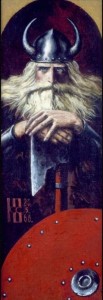Greaves asserted, “Early in 1941 administration officials reached a secret agreement with British and Dutch officials, which committed us to go to war against Japan if Japanese forces crossed a certain line.”
Three Assessments of the Infamy of December 7. 1941
PERCY L. GREAVES, Jr.
AT DAWN WE SLEPT: THE UNTOLD STORY OF PEARL HARBOR by Gordon W. Prange, in collaboration with Donald M. Goldstein and Katherine V. Dillon, McGraw Hill, 889pp, $22.95.
THE PACIFIC WAR, by John Costello, Rawson Wade, 742pp, $24.00.
INFAMY, by John Toland, Doubleday, 366pp, $17.95.
The Pearl Harbor disaster marks much more than the worst naval, military and diplomatic defeats in American history. It represents the culmination of a half century movement to discard the philosophy of our Founding Fathers-a philosophy that had attracted millions of immigrants to our shores in their pursuit of personal prosperity in the land of the free and of limited government. Pearl Harbor, and its aftermath, dropped a curtain over the economic failures of the New Deal policies of ever-increasing political spending and a politically controlled economy in an attempt to solve the government-created problems of inflation and mass unemployment. It also launched the full flowering of a new form of imperialism, whereby it is assumed that the President of the United States is not only the chief policeman of the world, but also the chief dispenser of largess at home and abroad.
Dates not in quotations are given in the European or American-military style, in accordance with The JHR style. - P.L.G.
It has long been this reviewer’s contention that the true story of Pearl Harbor is too complex, interwoven and unbelievable to be presented in a single volume. Nevertheless, three brave men have recently attempted to do so. Their books all read well. An uninformed reader of any one might well think that book very informative. The reader of all three is more likely to be confused than enlightened.
The Prange book is a full-fledged one-sided defense of the position to which the Roosevelt adulators have been driven by the revelations of facts long hidden from the public. Oddly, the authors of its Introduction hope “it raises more questions than it provides answers.” This it does. The Costello book is the work of a truth-seeking Englishman with a bias that it was our duty to save England and the world from the scourge of Hitler. Much of the book’s “significant new evidence,”[1] though it may be interesting and informative to many, can be found buried in material made public in 1945 and 1946. The Toland book is a far from complete story. However, it is the one that provides us with the most new, valuable and interesting information on what contributed to this highly important disaster and the attempts made to cover up the truth. Its many contributions will have to be taken into consideration by all future historians of this event.
At Dawn We Slept
Prange died in May 1980, so two of his former students - Donald L. Goldstein and Katherine V. Dillon - have edited his massive manuscript into its published form. They claim he tried “to be as objective as humanly possible.”[2] Possibly so, if one accepts the “new imperialism” as a basis for weighing what he found. However, if one accepts the constitutional concepts of our Founding Fathers, it becomes difficult to believe that “Washington had very little practical option.”[3] Even if one accepts the “new imperialism” philosophy that the problems of the Far East were the problems of the United States in general and our President in particular, Prange, like many others, completely ignores the fact that the basic controversy in that area was between the expansionist policies of the communist-minded Soviet Union and the largely western-oriented Japan in need of raw materials and markets for her finished goods.
Prange is silent on the Soviet attempts to disrupt Japan’s commercial and industrial developments on the mainland. Yet, it was the “commies” and the lack of local government protection that created “incidents” which led to Japan’s questionable military operations on the mainland. President Roosevelt sided with a weak Chinese government which could not control the terroristic devastations of either the “war lords” or the “commie” trouble makers, much less maintain peace in the market place. Franklin Delano Roosevelt (FDR) severed our trade treaty with Japan in the summer of 1940. He, thus, consciously or unconsciously, took the side of the Soviet Union in the Far East squabble. After Hitler invaded the Soviet Union, FDR considered the Soviets our allies and provided them Lend-Lease aid. At the same time meaningful negotiations with the Japanese ceased, as FDR drew an even tighter noose around Japan’s economic neck. Prange’s objectivism consists in believing Roosevelt had no choice and that while he may have made some small human errors in details, his overall policies were heroic. He does, on occasion, admit there were some peace-minded people in Japan, but the war-minded military expansionists won out. That this may have been the result of FDR’s personal anti-Japanese policies is not one of Prange’s positions.
When it gets to the investigations, we learn that “Stimson’s suggestion” of Supreme Court justice Owen J. Roberts “was a good choice to direct the investigation”[4] that cleared FDR, Stimson, Marshall et al of any responsibilities, while placing full blame on the Hawaiian commanders, Admiral Husband E. Kimmel and General Walter C. Short. Prange neglects to state that Roberts had been an interventionist advocate before Pearl Harbor. He, Prange, tells us the Hart Inquiry produced “valuable material,”[5] but he fails to cite any, preferring the later, refreshed testimony that attempts to refute the earlier evidence. Forced to admit that under oath neither General George Catlett Marshall nor Admiral Harold R. Stark could recall the most important days and events in their lives, he takes refuge in “witnesses like Stark and Marshall who frankly admit that they do not know or remember everything can be more credible than those who testify in assured detail to matters of which they have no direct knowledge.”[6] That should take care of those who knew of and acted on the receipt of the still missing “winds execute” message that indicated war with the United States and Britain. When Senator Homer Ferguson’s vigorous questioning of Marshall during the Congressional investigation placed a number of damaging facts in the record, we read that he “kept Marshall on the stand for an incredible nine and a half hours. His first session … covered a potpourri of subjects which we need not examine.”[7]
While he does admit the War and Navy Departments failed to send vital information they had to the Pearl Harbor commanders, it would take another book of 800 pages to balance, correct and refute the one-sided presentation of the book’s selected “facts” and deductions. However, as one the book calls a “gifted, convinced revisionist,”[8] this reviewer must comment on the final section of the book that ends with this sentence:
But in a thorough search of more than thirty years, including all publications released up to May 1, 1981 we have not discovered one document or one word of sworn testimony that substantiates the revisionist position on Roosevelt and Pearl Harbor.[9]
The section starts off by admitting that some of the conclusions of “the more reasonable revisionists” are “arguable.”[10] Then he tells us:
According to Beard, the President was a warmonger who deceived the American people, violated his antiwar campaign pledge of 1940, and maneuvered the Japanese into firing the first shot.[11]
Part of his rebuttal reads:
Percy L. Greaves, Jr., too, conceded, “Washington did not know, or at least no evidence has been adduced that Washington knew, precisely, that the attack would fall on Pearl Harbor although they (sic) had good reason to expect that it might.”[12]
That has been my position since 1946 and still is. However, Prange neglects three now well established facts: (1) That FDR was reelected in 1940 with the help of public promises that we were not going to fight in any foreign wars, while he was secretly promising aid to the British once the election was won; (2) That FDR precipitated the attack with an ill-considered ultimatum he knew Japan could not accept; and (3) That FDR told his War Cabinet on 25 November 1941, that an attack could be expected as soon as next Monday. Unfortunately, FDR’s attention was on the Japanese convoys moving south toward Thailand and Malaya. His chief worry in late 1941 was whether Congress and the country would back him up in keeping his secret unconstitutional promises to Britain that we would join the war if the Japanese, as they drove for the vitally needed oil we would not let them buy, passed us by and, attacked only British or Dutch territory.
Prange claims that when William Henry Chamberlin states the Japanese task force was “under the command of Admiral Isoroku Yamamoto,” he made “a mistake … the sort of factual error that casts doubt upon a (sic) historian’s credibility.”[13] Actually, the task force was operating under the orders of Admiral Yamamoto, who sent the final attack orders from his headquarters in Japan. That was a little one. Now for a big one:
Greaves asserted, “Early in 1941 administration officials reached a secret agreement with British and Dutch officials, which committed us to go to war against Japan if Japanese forces crossed a certain line.” It so happened that representatives of the U. S. and British Army and Navy staffs held discussions in Washington from January 29 to March 27, 1941. These discussions culminated in a secret military agreement (ABC-1 of March 1941). Roosevelt did not approve ABC-1 … Doubtless this is the “secret agreement” to which Greaves referred. However, both Marshall and Stark withheld approval because, among other reasons, ABC contained “political matters” and the proposals set forth did not constitute “a practical operating plan.” These plans and discussions did not commit the United States politically to go to war with Japan, Germany, or both; they outlined the military strategy to be followed if the country joined the conflict.[14]
While only Congress can constitutionally declare war, this “secret agreement” by “administration officials” did commit “us to go to war against Japan if Japanese forces crossed a certain line.” A statement signed by the Secretary of the joint Board was introduced into the hearings, stating that the President had “familiarized himself” with the agreement, but “he would not approve the report at this time.”[15]
Unfortunately, the original copy, signed by the “administration officials” could not be located. However, on 3 April 1941, Stark sent each of the Commanders in Chief of the three United States fleets “two copies of the Report (Short title ABC-1).” His official letter stated:
This Report has been approved by the Chief of Staff of the Army and by myself and, at an appropriate time is expected to receive the approval of the President … The basic idea of the United States-British plan is that the United States will draw forces from the Pacific Fleet to reinforce the Atlantic Fleet, and that the British will, if necessary, transfer naval forces to the Far East to attempt to hold the Japanese north of the Malay Barrier … The question of our entry into the war now seems to be when and not whether.[16]
This 3 April letter, just quoted, was distributed to the Congressional Committee members as part of Exhibit #106. However, the printed record omitted it from that exhibit. Perhaps it was because of Stark’s next letter to Kimmel, dated 4 April, which said:
Yesterday, I sent an official letter to you … Spent over three hours with him [the President] day before yesterday and another hour yesterday. My official letter on the staff conversations had some thoughts in it as a result of that Conference. I may tell you and Hart and King, in the strictest confidence and I mean by that nobody but you and Hart and King, that I read to the President the official secret letter which I mailed you three yesterday and received his general assent to it… I am also enclosing a memorandum, which I regard as vitally secret and which I trust you will burn as soon as you have read it, covering the President’s talk with Ghormley and me yesterday.[17]
Admiral Robert Lee Ghormley was the Navy’s representative to the British government.
Stark’s Chief of War Plans, Admiral Richmond Kelly Turner, testified before the Hart Inquiry:
WPL-46; Rainbow 5, it was known as. That war plan was a joint plan between the Army and the Navy. It had its basis in an international agreement with the British Army, Navy and Air Force … It was a worldwide agreement … On the conclusion of that agreement with the British, the WTL-46 was prepared after a great many talks with the Army and was approved bf the joint Board, the Secretaries of War and Navy, and by the President. The Navy issued their form of that war plan in May of 1941.[18]
He also testified that:
In May of 1941, decision was reached jointly with the British Government to occupy the Azores. The force which was withdrawn from the Pacific at that time … That project was abandoned and the occupation of Iceland by American troops was substituted.[19]
Stark’s Assistant Chief of Naval Operations, Admiral Royal E. Ingersoll later told the Hart Inquiry:
The transfer of ships from the Pacific to the Atlantic was in accordance with WPL46, which, in turn, was based on the U.S.-British conversations which culminated in the plan known as “ABC-1.”[20]
The Navy Court of Inquiry asked Stark, “Who approved the joint Army and Navy Basic War Plan Rainbow 5?” He replied, “It was approved by the Secretary of War, the Secretary of the Navy, and the President.[21]
When Stark appeared before the Congressional Committee, his distributed statement read, “Based on the understandings arrived at in ABC-1, the Army and the Navy developed a joint Basic War Plan known as Rainbow No. 5, which was approved by the Secretaries of War and the Navy and by the President.” In reading his statement, he said he had crossed out the words “and by the President” because he was told to do so when he submitted the statement to the Navy Department the day before. His reason for doing so, which this reviewer heard him state, has been omitted from the printed record.[22]
General L.T. Gerow, Chief of Army War Plans, told the Roberts Commission, “the joint Army and Navy Basic War Plan-Rainbow No. 5 was approved by the President, the Secretary of War and the Secretary of the Navy in May 1941.”[23]
In a Joint Memorandum for the President dated 5 November 1941, Marshall and Stark concluded:
The basic military policies and strategy agreed to in the United States-13ritish Staff conversations remain sound … Military action against Japan should be undertaken only in one or more of the following contingencies:
(1) A direct act of war by Japanese armed forces against the territory or mandated territory of the United States, the British Commonwealth, or the Netherlands East Indies;
(2) The movement of Japanese forces into Thailand to the west of 1000 East or south of 10° North; or into Portuguese Timor, New Caledonia, or the Loyalty Islands.[24]
The SECRET Rainbow 5 states under “PHASE 1 - Initial tasks - Japan not in the war… Protect the territory and communications of the associated powers.”[25] The Associated Powers were understood to be the United States, Netherlands East Indies and the British Commonwealth, including Australia, New Zealand and India.
The reader can make his or her own decision as to whether or not there was a “secret agreement” in force in the spring of 1941, and whether “both Marshall and Stark withheld approval.”
Revisionists, being human, have made mistakes. Carried away emotionally by the blatant cover up propaganda of the “court historians,” they have on occasion let some of their deductions exceed the provable facts. This reviewer has opposed such claims and has constantly maintained that, as incomplete as the record is, the known facts prove that FDR deceived the American public and that his aides lied time and time again in an effort to cover up the truth. General Sherman Miles admitted in an affidavit that he was ordered by Marshall to commit perjury by refusing to tell the full truth.[26]
So much for the Prange effort, which certainly “raises more questions than it provides answers.”[27]
The Pacific War
John Costello’s book is an unfortunate one. He is an Englishman, too young to have any mature recollections of the times and conditions existing in Asia and this country in the years and crucial months preceding the Pearl Harbor disaster. Unlike Prange, he was unable to know, observe or interview any of the major participants. He was thus dependent on the written records he had time to examine in the short time he devoted to the subject. Although he knew of the joint Congressional Committee hearings, which he mistakenly refers to as the Senate hearings, his lack of familiarity with the contents of the some 44 volumes that were part of its record leaves much to be desired. On the subject of Pearl Harbor, he is an amateur, competing in the big leagues.
As most histories are written from the viewpoint of the victors, Costello, who matured in the post World War II era, has read only the generally accepted establishment view that it was right and proper for the United States to interfere in the Far East quarrels - quarrels that President Hoover, along with most Americans of his era and before, felt were matters about which the United States would not go to war. This new form of noblesse oblige imperialism is probably easier for an Englishman to accept than for a traditional American. Costello not only accepts it, but agrees with the pre-Pearl Harbor Roosevelt position that Japan was guilty of one-sided “aggression in China,”[28] and that “Japan was progressing toward a totalitarian Fascist state.”[29]
He gives little thought to the possibility that it was Communist infiltration from Siberia that was the underlying cause behind most of the early incidents that led to the Japanese military expedition. It may have been all right in 1901 for Japan to join with the United States, Britain, France, Germany and Russia in protecting her nationals in China. But somehow or other Japan was no longer entitled to protect her nationals or her commercial and industrial interests when what passed for the Chinese government could not maintain law and order. The trouble makers were never the “commies.” It was “the Japanese, who engineered ‘incidents’.”[30] So economic measures to strangulate Japan were desirable even though they led inevitably to a war to restrain Japan and make Asia safe for communist exploitation.
For the serious student, the book is a horror. Costello’s editors certainly let him down. The author apparently felt that only quotations needed to be documented. Consequently, many important statements are unsupported. Much worse is the fact that the documentation is all too often in error. Quotations are occasionally mangled or so edited as to modify the meaning of a longer quotation. Some of the documentation errors are to the wrong pages. Others are to the wrong books. Some are ludicrous, as references to pages 440 and 944 in a book that has only 266 pages. Too many are to an “op.cit.” many pages away; at least one is to a book not included in a rather skimpy bibliography for this subject.[31]
The book states that a Navy witness, who tried to send an alert to Pearl Harbor, “testified, the War Plans Division had I so amended the dispatch as to make it worthless’.”[32] The record does not show that the witness ever made such a statement. The page cited indicates the witness took the drafted message to the Chief of War Plans who “made a number of corrections in it, striking out all except the information parts of it, more or less.” The witness was told, “If you want to send it, you either send it the way I corrected it, or take it back to Wilkinson [his superior] and we win argue about it.”[33] The revised draft was left with Wilkinson, but never sent. A reading of the full testimony of the witness’s two appearances fails to reveal the words Costello places in quotation marks.
The Japanese Honolulu to Tokyo 6 December message ended, “the heavy cruisers and airplane carriers have all left. It appears that no air reconnaissance is being conducted by the fleet air arm.”[34] This appears in the book as, “ALL CARRIERS AND HEAVY CRUISERS ARE AT SEA. NO SPECIAL REPORTS ON THE FLEET OAHU IS QUIET … “[35] Why the author should take such liberties is hard to understand.
He was also unaware of why there was a delay in translating this “bomb plot” series. The message cited was read after the attack, but earlier ones were read in Washington before the attack after receipt from Hawaii by airmail. Airmail was only twice a week then. Contrary to Costello’s belief, Hawaii could have read the series promptly if Washington had alerted them. However, the Hawaii code experts had been ordered to devote all their energies to breaking the Japanese Naval code. So such messages in the minor consular code were forwarded to Washington for decoding. None of this vital information was ever sent to Hawaii. There are countless factual errors of differing importance, but not the kind a careful historian would permit to appear in print. We read on one page page about “the fall of Paris on July 18.” On the next page, we read, “on June 21, the day before Germany and France signed their armistice.”[36] Paris fell on 22 June.
The book reads: “Konoye on November 11 proclaimed ‘a new order in East Asia’ to save China from her traditional fate as the ‘victim of the imperialistic ambitions of the occidental powers’.”[37] For his source he cites another book. Actually, the date of Konoye’s radio speech was eight days earlier, 3 November, 1938. The translation in the official U.S. State Department volume does not include the words in the inner quotes. It does state:
The Chiang Kai-shek administration has practically been reduced to a mere local regime … What Japan sincerely desires is the development and not the ruin of China. It is China’s cooperation and not conquest that Japan sincerely desires. Japan desires to build up a stabilized Far East by cooperating with the Chinese people who have awakened to the need of self-determination as an Oriental race … It goes without saying that Japan will not exclude cooperation of foreign Powers. Neither she intends to damage the legitimate rights of the third Powers in China … The world knows that Japan is earnestly determined to fight it out with communism. What the Comintern intends to do is bolshevisation of the Far East and disturbance of world peace. Japan expects to suppress in a drastic manner the sources of the evils of bolshevisation and their subversive activities.[38]
One may legitimately doubt the sincerity of any diplomat, but that is no reason to misrepresent and misquote his actual words. On page 90 we read that Hitler invaded the Soviet Union on “July 22, 1941.” on the next page we read, “The day before Operation Barbarosa … June 21.” That was plain carlessness. But what about his crediting Lieutenant Commander A. D. Kramer with Captain L. F. Safford’s office,[39] or having Kimmel “sent out in February 1941,”[40] when he went out with the Fleet almost a year earlier and merely assumed the top command on 1 February? Costello confuses the “winds code” and “winds execute” messages,[41] as well as FDR’s full Cabinet and War Cabinet,[42] which included the Secretaries of War, Navy and State, along with the Chief of Staff and Chief of Naval Operations. He has FDR making a statement to his wife, Eleanor, that his source states was made to a judge in his wife’s presence.[43] It was about FDR’s face-saving message sent early in the evening of 6 December to the Japanese Emperor.[44] This was after he knew Japan’s reply was in-a reply that he had known since 22 November meant “things are automatically going to happen”[45] and which, when he saw 13 of its 14 parts, caused him to say, “This means war.”[46]
Costello even has Marshall out horseback riding when his 7 December duty officer, in a statement written on 8 June 1942, stated Marshall “arrived at the office at about 10:00 o’clock or shortly thereafter and had a series of conferences with staff officers from G-2 and the War Plans Division.”[47]
Costello is totally confused about the controversial message of 27 November to General Short signed “Marshall.” Actually, Marshall was out of town that day and had nothing to do with it. Secretary of War Henry L. Stimson, whom Costello calls Secretary of the Navy on page 83 and Secretary. of War on page 85, sent that message, which was primarily a copy of the one sent to General Douglas MacArthur in the Philippine Islands. The messages said, “You are directed to undertake such reconnaissance and other measures as you deem necessary.” Generals Short and MacArthur were both ordered to “report measures taken.”[48] Stimson was unfamiliar with the situation in Hawaii. Both Marshall and Short knew, if Stimson did not, that there were no Army planes available in Hawaii for long distance reconnaissance. Most of Hawaii’s B-17s had been sent on to the Philippines.
Costello, like many others, is bothered by the sudden 26 November decision to jettison the proposed United States “modus vivendi” as an answer to a Japanese proposed “modus vivendi.” It was designed to gain a delay of three months on the decision for war. While China objected furiously, it had been approved by the War Cabinet and the governments of Britain, Netherlands and Australia. On 26 November, Secretary of the Treasury Henry Morgenthau called on FDR as he received his breakfast in bed. Costello tells us: “Plainly Roosevelt had just received some news which had shaken him because ‘He had not touched his coffee’.”[49] From this non sequitur, he jumps to the conclusion “that whatever war warning the President received on the morning of November 26th, it almost certainly came from Churchill.” He then reasons the alleged war warning must have come “through an entirely confidential channel … the likely source and channel is to be found in the account of William Stephenson,” the British agent in New York whose duty was to get the United States into the war with FDR’s secret help. He believes the “go-between” was FDR’s son, James.[50]
While Costello states “there are no indications in the published accounts,” he presumes “there is good reason” to believe that 11 still sealed” papers “must cast doubt on Stimson’s account as well as the official version of why the United States so dramatically and unexpectedly reversed its policy toward Japan on the morning of November 26, 1941 … That some war warning was received in the White House that day was certainly believed by Admiral Kimmel … he certainly tried to establish the existence of such a warning.” As justification for this, he cites a question “Kimmel asked Stark” during the Navy Court of Inquiry. Actually, Kimmel asked the question during a cross examination of Admiral R. E. Schuirmann, the Navy’s liaison with the State Department. Kimmel asked, “Do you recall whether on or about 26 November you received information from the Office of Naval Intelligence that they had specific evidence of Japan’s intention to wage war against both Britain and the United States?”[51] Schuirmann refused to answer, claiming “his privilege against revealing state secrets.” The judge Advocate sustained the objection as “beyond the scope of direct examination.”[52]
Kimmel asked a series of questions “to ascertain the specific information which he was being denied.”[53] They all referred to intercepts of Japanese messages which were still classified “Top Secret.” Schuirmann refused to answer any of the questions Kimmel asked and the Court upheld Schuirmann’s objections. What Costello did not know was that these questions were based on a statement Captain L. F. Safford had prepared from memory, when the intercepts were missing from the files, for his testimony before the Hart Inquiry.[54] He was undoubtedly recalling a Hanoi-Tokyo Purple intercept translated on 26 November that said:
(Strictly Secret)
We are advised by the military that we are to have a reply from the United States on the 25th. If this is true, no doubt the Cabinet will make a decision between peace and war within the next day or so … Should, however, the negotiations not end in a success, since practically all preparations for the campaign have been completed, our forces shall be able to move within the day.”[55]
Another fact Costello did not seem to know was why Morgenthau was calling on FDR before breakfast on 26 November. Chaing Kai-shek was not the only one opposed to the “modus vivendi.” The communists were also active opponents. Chiang’s American adviser was no other than Owen Lattimore. Lattimore sent a key cable to Lauchlin Currie, Administrative Assistant to FDR, which said in part:
You should urgently advise the President of the Generalissimo’s strong reaction. I have never seen him really agitated before … Any “modus vivendi” … would be disastrous to Chinese belief in America … The Generalissimo has deep confidence in the President’s fidelity to his consistent policy but I must warn I you that even the Generalissimo questions his ability to hold the situation together if the Chinese national trust in America is undermined.[56]
Apparently Lattimore was also helpful with the cables that bombarded many top Administration officials as well as one that caused Churchill to send FDR a cable received at 6 a.m. 26 November stating:
It is for you to handle this business and we certainly do not want an additional war. There is only one point that disquiets us. What about Chiang Kai Shek? Is he not having a very thin diet? Our anxiety is about China. If they collapse our joint dangers would enormously increase. We are sure that the regard of the United States for the Chinese cause will govern your action. We feel. that the Japanese are most unsure of themselves.[57]
Morgenthau was one of the recipients of the loud cries from Chungking on 25 November. The first thing on the morning of the 26th, the Chinese Ambassador called on Morgenthau’s aide, Harry Dexter White, at the Treasury. White went to Morgenthau who left immediately for the White House to persuade FDR to receive the Chinese Ambassador and oppose the “modus vivendi“.[58] FDR did so and Hull was ordered to send an ultimatum everyone knew Japan could not accept.
Congressional committees have found that Lattimore, Currie and White were closely tied in with Communist interests in Washington. Regarding Costello’s speculation that there was another message from Churchill, it should be mentioned that the “neutral” FDR established the first “hotline” telephone with Churchill in May 1940.[59] While this “confidential channel” undoubtedly explains why some FDR replies to Churchill requests were not in the files, it is extremely doubtful that FDR was shaken by a “war warning” phone call from Churchill on 26 November.
Costello writes much of “new evidence.” He states “no detailed plan of the Pearl Harbor Attack … survived the Japanese destruction program at the end of the war.”[60] Actually, on 29 November 1945, MacArthur sent the Congressional Committee a copy of the plan and it was printed in 1946 as Exhibit No. 8-B.[61] Costello was intrigued to find “in the recently declassified records, an almost complete translation of Yamamoto’s first operation order … : COMBINED FLEET TOP SECRET OPERATION ORDER 1.”[62] This was part of the Committee’s Exhibit No. 8-D.
Costello informs us, “It is now possible to conclude, with some certainty, that it was not Stimson’s report that proved crucial. That ‘missing’ document has been recovered from the recently declassified Confidential File of the Secretary of War.”[63] Bravo! That “missing” document was printed in 1946 as Exhibit No. 98 of the Congressional Hearings.[64]
Costello shows his evident distaste for “isolationists,” “the isolationist press,” “isolationist pressures,” “the isolationist-inspired,” “the ‘professional pacifists'” as well as for his finding that an “isolation-dominated Capitol Hill” passed the Neutrality Act “to keep the United States in strict international purdah.”[65] Nevertheless, he does realize that FDR and Churchill, off Argentina in August 1941, secretly agreed to pursue parallel action against Japan and publicly signed the Atlantic Charter. “This proclaimed Anglo-Saxon unity to uphold Roosevelt’s Four Freedoms, but in spite of great press fanfares it was to leave unmoved the 75 percent of Americans who still opposed going to war against Germany.”[66]
Despite the many shortcomings, the book does contain a number of statements with which more Americans should be made familiar. He tells us that “the Soviet Union sent arms to Mao Tse-Tung’s guerrilla army” in China and forced Japan to choose either to accept a “stalemate or commit more forces to a military campaign to subdue the rest of China.”[67] In commenting on the “American isolationists” and their imagined machinations with the Axis, he informs us that “British undercover agents, with the unofficial blessing of the White House, were operating along with the FBI to expose such conspiracies at the risk of violating American constitutional rights.”[68]
He concludes that “the two ‘modus vivendi‘ positions were not irreconcilably apart. Significantly, the United States appeared ready to buy three more months of peace in the Pacific with a limited relaxation of the embargo and some encouragement on the Chinese to negotiate with Japan.”[69] He also quotes Churchill’s “November 23, 1941 minute to Anthony Eden” in which-he said, “I should feel pleased if I read that an American-Japanese agreement had been made by which we were able to be no worse off three months hence in the Far East than we are now.”[70]
He also reminds us that our veteran Ambassador to Japan warned FDR that the imposition of embargoes “could lead to open conflict.” He even states that both FDR and Hull “had been repeatedly warned by Ambassador Joseph Grew that Japan was being pushed into a diplomatic impasse from which war was the only exit.”[71]
While we can disagree that his “new evidence” adds much, some of his conclusions are certainly acceptable deductions from the known facts. For example:
There is every indication that a month before the attack on Pearl Harbor, it was the United States that had decided to bring about the rupture of discussions and was about to prepare for the worst. There is now evidence for believing that President Roosevelt was not only expecting war but possibly knew exactly when it would break out. Clues … on both sides of the Atlantic … suggest that after the third week in November 1941 the British and American governments had not only decided that war with Japan was inevitable-but they knew the attack would hit Malaya and the Philippines.[72]
According to a confidential British Foreign Office report ‘the President and Mr. Hull were … fully conscious of what they were doing.’… Whether such an accommodation [the modus vivendi] would have worked out in practice is less important than the fact that it was the United States which decided to abandon the modus vivendi - thereby making a Pacific war inevitable … In the light of subsequent events, this decision proved to have been one of the most momentous in America’s history.[73]
To which we say, “Amen.”
Infamy
The Toland book is a delight to read as well as the most informative of the three. He has pursued a number of previously unexplored leads with numerous interviews and a wide reading of pertinent sources. As a result, he has uncovered or confirmed much that is helpful in putting the complex Pearl Harbor jigsaw puzzle together. The book is not perfect or all inclusive, but it is probably the best volume on the subject to date.
While the book deals primarily with the attempted cover ups after the war, he does weave in many of the little-known important events and decisions that led up to the attack. Unfortunately, he does not develop fully the significance of his two major contributions - the Tyler Kent affair and the Stahlman letter.
His story of the Tyler Kent affair is the most revealing that this reviewer has seen in print. This case of the May 1940 British arrest and detainment, for the duration of the war, of an American code clerk with diplomatic privileges is one of the blackest marks on the record of the Roosevelt Administration. While Kent undoubtedly violated American law and regulations, there was no valid reason for the British to detain him. The waiver of his immunity certainly had to have the highest approval. If he had been expelled from England and tried by an American court, it would certainly have changed the course of history. Toland does not go into this aspect. However, if Kent had revealed the contents of the damaging FDR-Winston Churchill documents to Burton K. Wheeler of the U.S. Senate, rather than Captain A. H. M. Ramsey, of the British Parliament, this reviewer doubts that FDR would have obtained the 1940 Democratic Party nomination, much less a third term election. Without Roosevelt in the White House, it is difficult to imagine Pearl Harbor.
A few pages before the book’s end, buried at the end 6f a paragraph, we read:
One of Knox’s close friends, James G. Stahlman, wrote Admiral Kemp Tolley in 1973 that Knox told him that he, Stimson, Marshall. Stark and Harry Hopkins had spent most of the night of December 6 at the White House with the President: All were waiting for what they knew was coming: an attack on Pearl Harbor.[74]
Toland continues, “The incredulities continued,” but makes no further comment on this astounding bit of information. Mr. Stah1man was not just a close friend of Knox. He was a well known publisher and a man of substance - a veteran of World War I and the President of the American Newspaper Publishers Association 1937-39 who served in Washington during World War II as a Captain in the U.S. Naval Reserve. His letter is prime evidence. While we can agree that these men were expecting some kind of an attack, there is still no documented evidence that they were thinking of Pearl Harbor. All available records indicate their attention was on the Japanese convoys going south. This is confirmed by Knox’s spontaneous “My God, this can’t be true! This must mean the Philippines,” when informed of the attack.[75] The chief concern was whether we would be included in the attack and, if not, whether Congress and the country would endorse their secret desires, if not promise, to join in the defense of British and Dutch territory.
Think what this Stah1man letter means. It is certainly further proof that the testimonies of Stimson, Marshall and Stark are worthless. They could not recall. It also helps explain why so many of their underlings changed their earlier sworn testimony in order to conform with the desires of their superiors. We should no longer be surprised at the great lengths other “responsible” persons went to suppress the truth. After all, the record shows that Marshall ordered one of his aides to commit perjury before the Army Pearl Harbor Board. If one, were there not others?[76]
Toland does provide a large number of instances in which efforts were made to twist or suppress the truth. He adds much to the story of Marshall’s successful attempt to keep Thomas Dewey from mentioning in the 1944 Presidential campaign the pre-Pearl Harbor reading of Japanese codes. This was probably justified, as we were reading all Berlin-Tokyo diplomatic messages sent in the same system. However, few of the other attempts could be justified, particularly after the end of the war.
While there has been prior mention of the case of Chief Warrant Officer Ralph T. Briggs, Toland deserves great credit for breaking the full story. In doing so, he should end at last all doubt about the receipt of Tokyo’s “winds execute” message. Tokyo set up a “winds code” on 19 November. It was a false weather message designed to inform Japan’s consular and diplomatic representatives on the outbreak of war after they had destroyed their code books and machines. The code destruction orders went out on 1 and 2 December. So both Japanese and American radio stations were monitoring all weather broadcasts for the key words. Early testimony indicated that several persons
had seen the “execute” of the “winds code” message and a number of others testified they had been informed of its reception. The cover-up forces then tried to dispel the idea that this clear warning of war, or at least of the breaking of relations, with
Britain and the United States, was ever received.’ This had three purposes: (1) It would water down or divert attention from the clear warnings that war was imminent after our 26 November ultimatum to Japan; (2) It would help excuse the failure to send more information to the Pearl Harbor commanders; and (3) It would cast doubt on the testimony of those few witnesses who were trying to tell the truth.
Toland informs us of some of the methods used to suppress the truth. Secretary Knox had promised Kimmel permission to have an aide search the files for pertinent documents.[77] One day the Acting Navy Secretary, Admiral Ernest J. King, allowed Kimmel’s legal aide, retired Navy Captain Robert A. Lavender, to do so. He “extracted some forty-three messages, messages typical of what he thought should have gone to Kimmel.” As he looked at these messages, he “became nauseated,” and could not eat that evening while he was informing Kimmel’s other attorneys of their contents.[78]
The following day Marshall’s deputy telephoned the director of Naval Communications to vigorously protest Lavender’s visit to the secret files. Orders, he said, forbade such an inspection. When the director said he had received no such orders, the deputy hastily explained he merely meant that orders should forbid such inspection.
Even though the messages had been segregated and authenticated, the copies were not delivered to Lavender but kept in the custody of Naval Communications …[79]
Marshall also set up two Carter Clarke investigations to scotch growing rumors that he wanted suppressed. Under such interrogation, officers denied they had ever made the statements that others had quoted them as saying about the handling and rumored destruction of “secret” documents. Toland tells us how many of the pertinent documents were finally gotten into the record. This story alone is worth much more than the price of the book. The next tactic was for the Secretaries of War and the Navy to send “identical bills to the Chairmen of the Senate and House Armed Services Committees prohibiting disclosure of any coded matter.” With only one hearing “in camera” the bill was rushed through the Senate and sent to the House.[80] If passed into law, it would have destroyed any chance that the American public would ever learn the truth about Pearl Harbor. Toland tells us how this was prevented.
After telling us how the Navy Court of Inquiry and Army Pearl Harbor Board reversed the Roberts Report findings, that made Kimmel and Short the scapegoats, placing a major share of the blame on Marshall and Stark, Toland tells us how these reports were first suppressed. Then, both the Army and Navy set up separate further investigations to discredit the official findings of Admirals and Generals. Prior witnesses were shown the testimony favorable to the cover up and attempts were made to persuade them to change their earlier testimony. Some did, even though one had given his first testimony based on a statement composed by two Marshall aides within a week after Pearl Harbor. Others were persuaded they must have confused a false “winds execute” message with the real one.
There had been a number of private meetings at which witnesses were worked on. One key Navy witness, confined to the psychopathic ward at Bethesda Naval Hospital, was released for a meeting at Stark’s home. He changed his original testimony and received a medical discharge right after the Congressional Committee issued its reports. Another Navy officer admitted he changed his “winds execute” testimony “because, up until… about 2 months ago, I thought the entire thing in that Wind message was authentic … On talking to some of the officers who had gone into it … they said it had been found out later that that was a false broadcast … but it was news to me at that time.”[81]
While Toland has made available much valuable material which every informed American should know, the firsi printing does have a number of errors. Most of them are minor and should be corrected in later printings.
He states that Stimson’s persistent hatred and fear of Japan began “while he was Hoover’s Secretary of State, with the Japanese conquest of Manchuria in 1932.”[82] He should have traced it back to when Stimson was the Governor General of the Philippines from 1927 to 1929. In fact, it was this “hatred and fear” that led him to accept the Secretary of State position in prefbrence to that of the Attorney General, thus leaving that position open for William D. Mitchell, the Congressional Committee’s first Counsel, who resigned when he failed to railroad the Committee’s Pearl Harbor hearings to an early conclusion.
The book tells us that Marshall’s 7 December 1941 secretary, Colonel Walter Bedell Smith, as a Lieutenant General and Eisenhower’s Chief of Staff, “flatly denied Colonel Sadtler’s claim that he had asked Smith and Gerow on December 5 to authorize him to send Hawaii a warning.”[83] Actually, Smith fell back on the standard Marshall-Stark “do not recall” answer. He signed and swore to an affidavit which stated, “I do not recall Colonel Sadtler’s coming to me as he has stated.” In the same affidavit he swore, “To the best of my recollection … if the intercepted radio message referred to by Colonel Bratton was delivered” to him on the night of 6 December 1941 as Bretton first testified, “it would have been delivered to the Chief of Staff in accordance with our usual procedure.”[84] Note how craftily he does not actually deny the testimonies of his fellow officers who remained Colonels throughout the war.
Writing about the “modus vivendi” requested by Marshall and Stark, seeking a three months’ delay in the breakdown of negotiations with Japan and which had been approved on 25 November by the War Cabinet as well as the British, Dutch and Australian governments, the book states: “Later in the day [the 25th] a cable for Roosevelt arrived from Churchill.”[85] Actually this key cable left London at 12:55 a.m., London time, on the 26th and reached Washington at 6 a.m.[86]
Where Toland tells us “the President ordered Stimson to send out ‘the final alert,'”[87] Stimson’s diary states, “I suggested and he approved.” Where the book states that on 28 November “Stimson took the offensive. Strike the Japanese force as it went by - without warning!“[88] the diary entry reads:
It further became a consensus of views that rather than strike at the Force as it went by without any warning … the only thing for us to do was to address it a warning that if it reached a certain place, or a certain line, or a certain point, we should have to fight.”[89]
The book includes Knox among those who “felt obliged to join in the cover-up and make scapegoats of two innocent men, Kimmel and Short.”[90] Actually, Knox died on 28 Aprill 1944, before the Navy Court of Inquiry. Before his death, he did grant Kimmel permission to search the Navy files. It was Marshall and Knox’s successor, James Forrestal, who shut that door. Safford told this reviewer that he felt that if Knox had lived, he would have let the truth come out. We shall never know.
Toland tell us how President Harry S. Truman released the reports of the Navy Court of Inquiry and the Army Pearl Harbor Board shortly after V-J Day.[91] He fails to note that these were only the SECRET reports and did not include the TOP SECRET reports which dealt with the testimony concerning the all-important decoded Japanese intercepts the cover-up boys tried so hard to keep secret. These were released some time later after a considerable controversy.
A rather odd change crept into the Toland book between the manuscript and the printed pages. The book has Marshall “vacationing in Florida with his wife” on 27 November 1941, the day that Stimson drafted a key message over Marshall’s signature for MacArthur with a duplicate to Short with the added phrase “these measures should be carried out so as not to alarm civil population or disclose intent.”[92] This was also the date of the important joint Marshall-Stark memorandum to the President pleading for more time. Available records indicate Marshall left for Army maneuvers on the 26th and was back in his office on the morning of the 28th. If Toland has uncovered new information, it would have been helpful if he had provided the source.
Toland does establish that Kimmel and Short were not the scapegoats the Administration tried to paint them. He also tells of some of the calumny and sleepless nights these men had to suffer as some called them murderers while a number suggested they shoot themselves. The lives of these dedicated, innocent officers were a literal hell on earth for years as they had to suffer in silence. They were great Americans and Kimmel certainly proved himself a great fighter.
There was one real hero in all this infamy. It was my good friend, Laurence Frye Safford. He, too, suffered the torments of hell as he stuck to telling the truth, the whole truth and nothing but the truth. After all these years, it is good to see a book that presents his story fairly. If it had not been for him, the cover-up boys would have buried the truth where it never could be found. It was he who provided Kimmel with the ammunition to fight. It was he who located and replaced many of the vital intercepts the cover-up boys thought had all been destroyed. It was also he on whom so much shame, ridicule and harassment was heaped. He sacrificed his own career, but he refused to sacrifice that of Briggs, whose superiors ordered him not to disclose the truth about the “winds execute” message which Toland’s INFAMY now reveals.
Toland concludes that “a number of reports to Washington indicated” to Roosevelt that the Japanese carriers were “heading eastward to Hawaii.”[93] His evidence is tenuous. For years there were rumors, reports, novels, war games and speculations that Japan would start a war against the United States with a surprise attack on Pearl Harbor or our fleet, wherever it was. These were bandied about in the U. S. Navy as elsewhere. No doubt they continued right up to 7 December 1941. They were so numerous and conjectural that they were unfortunately put aside, though they should not have been, when all the concrete intelligence pointed to a southern Japanese attack force that might, or might not, sail into the Philippines.
The Japanese carriers were under orders to maintain radio silence. They would have been foolish to disobey those orders. Japanese sources have confirmed their silence. Seaman First Class Z and the Lurline radio operators may have heard the “noise” of the brief orders sent the carriers from Japan, but they could not have detected carriers moving in radio silence. There were last minute attempts to alert Washington from both the Netherlands East Indies and Australia. But so far as the record reveals, these all dealt with Japan’s southern movements. The Japanese were most secretive about the Pearl Harbor attack plans and had no reason to disclose them to their representatives in Southeast Asia. In any case, there is no hard evidence that any of these reports actually got to the President.
Perhaps some information did. However, all the massive evidence from many, many sources indicates that the attention of FDR and his top advisers was on the Japanese convoys moving south. This long-time student of the Pearl Harbor story has long maintained that there is no need to go beyond established evidence. When one does, it provides an attractive target for the opponents of truth-seeking revisionists. Such speculative claims have hurt the revisionist movement in the past. The treatment given this great book by the WASHINGTON POST is an example of the damage such claims can do. There is a temptation to concentrate on the one questionable claim and thus neglect the many well-documented facts being published in such detail for the first time by such a talented and experienced author.
Washington had plenty of evidence that the United States was going to be attacked. The “winds execute” in conjunction with the Purple and “bomb plot” intercepts and the places where Japanese codes were being destroyed were clear evidence. As to knowledge the attack was to be on Pearl Harbor, this revisionist historian still holds his 1952 position quoted by Prange:
Percy L. Greaves, Jr., too, conceded, “Washington did not know, or at least no evidence has been adduced that Washington knew, precisely, that the attack would fall on Pearl Harbor although they (sic) had good reason to expect that it might.[94]
Despite his many damning discoveries and disclosures, Toland is timid about blaming FDR, the man at the helm whose policies and decisions, as well as those of his personally-selected aides, led to the Pearl Harbor disaster. He concludes: “There were no heroes or villains on either side… The villain was the times.”[95]
Nevertheless, Toland deserves great credit for his efforts. In his pursuit of the truth, he has not been hesitant about changing positions he took in his earlier books. This is the sign of a true scholar. He has made a priceless contribution to the annals of American history. This book should be required reading, not only for every student of government and history, but also for every American who wants to be informed on the shenanigans that cost the loss of so many innocent lives and hid the economic failures of the New Deal policies which are the main cause of our current economic dilemma of inflation, mass unemployment and capital consumption.
Compared with Pearl Harbor, Watergate was a tempest in a teapot. Compared with Prange, Costello and the court historians, Toland is a giant among modern historians.
Infamy: Pearl Harbor and Its Aftermath by John Toland is available from the Institute for Historical Review, $18.00
Footnotes
|
Abbreviations |
Full Titles |
|
Cong. Hrgs. |
Hearings of Joint Congressional Committee on the Investigation of the Pearl Harbor Attack, U.S.Govt. Printing Office, 1945/46. |
|
Costello |
The Pacific War, by John Costello, Rawson Wade, 1981. |
|
Lash |
Roosevelt and Churchill, 1939-1941, by Joseph P. Lash, W. W. Norton & Co., Inc., 1976. |
|
Prange |
At Dawn We Slept: The Untold Story of Pearl Harbor, by Gordon W. Prange, McGraw Hill, 1981. |
|
Perpet. War |
Perpetual War for Perpetual Peace, Harry Elmer Barnes, ed. Caxton Printers, Ltd., 1953. Chapter by Percy L. Greaves, Jr., “The Pearl Harbor Investigations.” |
|
Sen. Jud. |
U. S. Senate Subcommittee on Internal Security, The Harry Dexter White Papers, U.S.Govt. Printing Office, 1956. |
|
Toland |
Infamy, by John Toland, Doubleday, 1982. |
|
U.S. For. Rel./J. |
United States Foreign Relations, Japan (1931-1941), U.S.Govt. Printing Office, 1943. |
|
U.S.N. Pro. |
United States Naval Institute, Proceedings, Annapolis, Md. |
Footnote/Source/Page
- Costello, x
- Prange, ix
- Prange, xii
- Prange,592
- Prange,618
- Prange,629
- Prange,688
- 6. Prange,725
- Prange, 850
- 10 Prange,839
- 11 Prange,839/40
- 12 Prange,840
- 13 Prange,840
- 14 Prange,845/46
- 15 Cong. Hrgs. Vol. 3-995
- 16 Cong. Hrgs. Vol. 33-1357
- 17 Cong. Hrgs. Vol. 16-2160/61
- 18 Cong. Hrgs. Vol. 26-264
- 19 Cong. Hrgs. Vol. 26-266
- 20 Cong. Hrgs. Vol. 26-460
- 21 Cong. Hrgs. Vol. 32-70
- 22 Cong. Hrgs. Vol. 5-2102
- Cong. Hrgs. Vol. 24-2160
- Cong. Hrgs. Vol. 33-1239
- Cong. Hrgs. Vol. 37-846&850
- Cong. Hrgs. Vol. 35-101
- Prange, xiii
- Costello, 4
- Costello, 51
- Costello, 62
- Costello, 704 (p.606n)
- Costello, 646
- Cong. Hrgs. Vol. 8-3388
- Cong. Hrgs. Vol. 12-270
- Costello, 126
- CosteHo, 68/69
- Costello, 61
- U.S. For. Rel./J. Vol. 1-479/480
- Costello, 86
- Costello, 87
- Costello, 645 et al
- Coste a, 119
- Costello, 124 & Lash, 486
- Toland, 301
- Cong. Hrgs. Vol. 12-165
- Cong. Hrgs. Vol. 10-4662
- Cong. Hrgs. Vol. 14-1411
- Cong. Hrgs. Vol. 14-1328/29
- Costello, 629
- Costello, 633
- Costello, 633/34
- Cong. Hrgs. Vol. 33-732
- Costello, 634
- Cong. Hrgs. Vol. 26-390
- Cong. Hrgs. Vol. 12-174
- Cong. Hrgs. Vol. 14-1160
- Cong. Hrgs. Vol. 14-1300
- Sen.jud.2733
- U.S.N. Pro. Dec. 1969-67
- Costello, 635
- Cong. Hrgs. Vol. 13-415
- Costello, 635 & Cong. Hrgs. Vol. 13-425
- Costello, 630
- Cong. Hrgs. Vol. 16-2014
- Costello, 49/51 passim
- Costello, 96
- Costello, 60/61
- Costello, 615
- Costello, 623
- Costello, 625
- Costello, 94&627
- Costello, 615/16
- Costello, 627/28
- Toland, 320
- Cong. Hrgs. Vol. 3-3829
- Cong. Hrgs. Vol. 35401
- Toland, 81
- Toland, 82
- Toland, 82
- Toland, 133/34
- Cong. Hrgs. Vol. 4-2035
- Toland, 26
- Toland, 141
- Cong. Hrgs. Vol. 35-91
- Toland, 267
- Cong. Hrgs. Vol. 14-1300
- Toland, 274
- Toland, 277
- Cong. Hrgs. Vol. 11-5436
- Toland, 323
- Toland, 145
- Cong. Hrgs. Vol. 14-1328/29
- Toland, 316
- Prange 840 & Perpet. War, 425
- Toland, 276
Source: Reprinted from The Journal of Historical Review, vol. 3, no. 3, pp. 319-340.
Published with permission of and courtesy to the Institute for Historical Review (IHR).
For the current IHR catalog, with a complete listing of books and audio and video tapes, send one dollar to:

